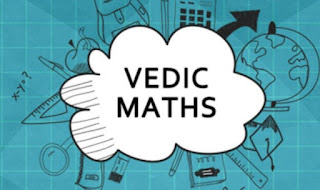VEDIC MATHS
By OMKAR TENDOLKAR
Hello friends,
This is post number 103 from the series of "Vedic maths" blogs. Here in this blog we will learn about "Applications of the Sutras & Sub-sutras - 3"
VEDIC MATHEMATIC :
"VEDIC MATHEMATICS" is the name given to the ancient system of mathematics, or, to be precise, a unique technique of calculations based on simple rules and principles, with which any mathematical problem be it arithmetic, algebra, geometry or trigonometry can be solved, hold your breath, orally!
What we call "Vedic Mathematics" is a mathematical elaboration of 'Sixteen Simple Mathematical formulae from the Vedas' as brought out by Sri Bharati Krishna Tirthaji.
Sutras:
The system is based on 16 Vedic sutras or aphorisms, which are actually word formulae describing natural ways of solving a whole range of problems.
Some examples of sutras are "By one more than the one before", "All from 9 & the last from 10", and "Vertically & Crosswise". These 16 one-line formulae originally written in Sanskrit, which can be easily memorized, enables one to solve long mathematical problems quickly.
5. Sunyam Samya Samuccaya ( When the sum is the same, the sum is zero )
This is related to equating with zero. For example, as x is common factor in the equation “14x + 5x…… = 7x + 3x…..”, x will equal to 0.
Example I : 9(x+3) = 4(x+3)
According to the definition, Since x+3 is a common factor, x + 3 = 0 that’s why, x = -3
Calculation with a simple algebraic method,
9x + 27 = 4x + 12
5x = -15
x = -3
Example II : 4(x-1) = (x-1)
here there is common factor of x-1 on both sides. So
x - 1 = 0
x = 1
The sutra when "Samuccaya is the same it is zero" was in fact in use when we were casting out nine or figure that total nine.
Example I:
Find the Digit sum of 425.
we can cast out the 4 and 5, as they total nine, and give the digit sum as 2.
when total is same (as 9) it is zero (can be cast out). (The term samuccaya means combination or total)
( For more information refer -: VEDIC MATHS-39 )
6. Anurupye – Sunyamanyat ( If one is in ratio the other one is 0 )
We use this Sutra in solving a special type of simultaneous simple equations in which the coefficients of ‘one’ variable are in the same ratio to each other as the independent terms are to each other. In such a context the Sutra says the ‘other’ variable is zero from which we get two simple equations in the first variable (already considered) and of course give the same value for the variable.
Example 1:
3x + 7y = 2
4x + 21y = 6
Observe that the y-coefficients are in the ratio 7 : 21 i.e., 1 : 3, which is same as the ratio of independent terms i.e., 2 : 6 i.e., 1 : 3.
Hence the other variable x = 0 and 7y = 2 or 21y = 6 gives y = 2 / 7.
In next blog we will discuss about "Applications of the Sutras & Sub-sutras - 4".
Are you excited for this?...
Then, please wait for it.
I will post my new blog in next week.
We will meet very soon through our next blog. Till that stay connected, stay healthy and stay safe.
Thanks
for giving your valuable time.
Good day😊


Comments
Post a Comment